ORS-1 (Operationally Responsive Space-1)
EO
Mission complete
High resolution optical imagers
Land
Quick facts
Overview
| Mission type | EO |
| Agency | ORSO |
| Mission status | Mission complete |
| Launch date | 29 Jun 2011 |
| End of life date | 01 Jan 2017 |
| Measurement domain | Land |
| Instrument type | High resolution optical imagers |
| CEOS EO Handbook | See ORS-1 (Operationally Responsive Space-1) summary |
ORS-1 (Operationally Responsive Space-1)
Overview Spacecraft Launch Mission Status Sensor Complement Ground Segment References
ORS-1 is the first operational imaging satellite of the ORS (Operationally Responsive Space) program, managed by the Space Development and Test Directorate, located at Kirtland AFB (Air Force Base) on behalf of the Operationally Responsive Space Office (ORSO), also located at Kirtland AFB in Albuquerque, NM, USA. It is an important milestone to demonstrate the capability to meet emerging and persistent warfighter needs in operationally relevant timelines. By building systems on smaller satellites using modular components, the ORS (Operationally Responsive Space) program provides the ability to rapidly augment U.S. space systems. ORS can deliver capabilities in a fraction of the time it takes to build larger platforms. 1) 2)
The ORS program was established in May 2007 by the DoD (Department of Defense) as a proactive step to adapt space capabilities to changing national security requirements and to be an agent for change across the community. Taking a new approach to risk and mission assurance to rapidly deploy capabilities that are "good enough" to satisfy warfighter needs across the entire spectrum of operations, from peacetime through conflict is the path being taken for ORS employment. The goal of the ORS concept is the ability to address emerging, persistent, and/or unanticipated needs through timely augmentation, reconstitution, and exploitation of space force enhancement, space control, and space support capabilities. The ORS-1 project was initiated as a result of a requirement from the Commander of U.S. Strategic Command to the ORS Office to support U.S. Central Command's (USCENTCOM) need for enhanced battlefield awareness. 3) 4)
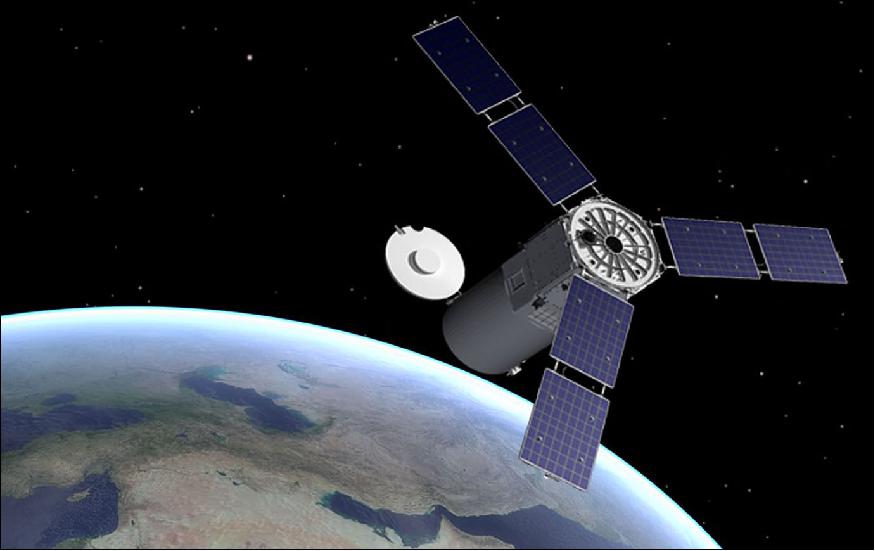
Spacecraft
The ORS-1 minisatellite is part of a larger effort by DoD to build and launch satellites faster, typically within 24 months of approval, and to put those satellites under the direct control of warfighters for faster response time in tasking and receiving information. ORS-1 represents a fundamental change in the U.S. military satellite acquisition process.
The ORS-1 mission was led by the ORSO (Operationally Responsive Space Office) and partners including the U.S. Strategic Command, U.S. Central Command, the Space and Missile Center's Space Development and Test Directorate, the Air Force Space Command's 50th Space Wing, U.S. Army, NRL (Naval Research Laboratory), the NASA Wallops Flight Facility, Goodrich Corporation's ISR (Intelligence, Surveillance & Reconnaissance) Systems (Danbury, CT), ATK Spacecraft Systems and Services, L-3 Communications, OSC (Orbital Sciences Corporation), Lockheed Martin, General Dynamics, The Aerospace Corporation, and TASC Inc.
Goodrich, the lead systems integrator for the ORS-1 program, provided the satellite's sensor payload. The payload leverages the latest evolution of Goodrich's SYERS (Senior Year Electro-Optical Reconnaissance System) multispectral sensor, initially used on the U-2 reconnaissance plane (of Lockheed) and deployed in theater operations for more than 35 years. Goodrich also provided a ground segment to process the data from the sensor payload to be in compatible formats with the downstream exploitation, and dissemination used for the operational SYERS sensor.5)
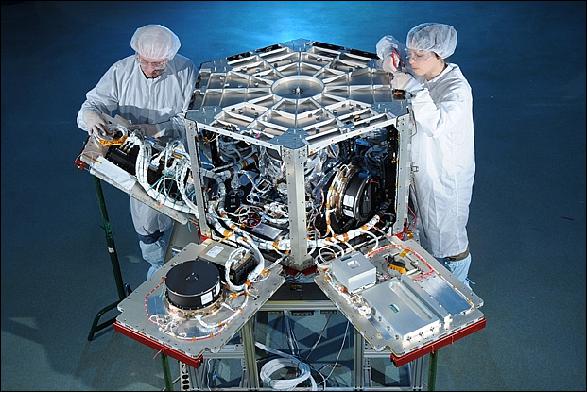
The ORS-1 spacecraft bus, referred to as ATK A200, was built by ATK Space Systems and Services (Beltsville, MD) and was based on their TacSat-3 bus (launch May 19, 2009). The modular bus provides precision pointing with an agile three-axis stabilization system , power and thermal management, orbital maneuvering and payload support functionality. The ATK designed and built spacecraft bus meets the ORS-1 goals of being operationally responsive, low-cost and high performance. It includes an integrated propulsion system [the propulsion subsystem is comprised of an Aerojet procured PROP plus and an ATK-provided propulsion control unit (PCU) and Prop deck] as well as other critical subsystems for communications, attitude control, thermal control, and command and data handling. ATK's innovative hexapetal bus design enables rapid integration and modular packaging of both bus and payload components - an enabling capability for future ORS (Operationally Responsive Space) missions that must meet a seven-day call-up requirement.
Other innovative features of the ATK spacecraft design include the adoption of Integrated Systems Engineering Team standard interfaces, that were developed in parallel by a joint government-industry team of engineers; an agile three-axis stabilization system to enable payload sensors to collect precision data on-orbit and downlink processed information in the same orbit pass; a robust power capability with modular power options that can be tailored for specific mission requirements; and a high-strength structure with adaptable interfaces to support a variety of sensor payloads.
ORS-1 was built with a one year design life and a two year lifespan goal; it has a mass of about 475 kg and features robust power capability with 900 W (max). The first SpaceCube 1.5 system is flown on the ORS-1 minisatellite.
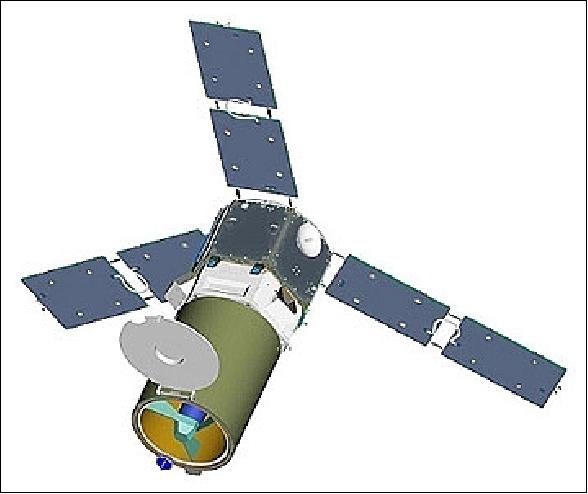
Final assembly and testing of the ORS-1 space vehicle was completed at the Goodrich Danbury, CT facility. Although MIL-STD-1540 was the basis for qualification testing requirements, extensive tailoring was adapted to reduce cost and schedule.
ATK's spacecraft bus met the ORS program goals of being operationally responsive with affordable technology and unprecedented rapid execution from design to launch. ATK built the bus in just 16 months at its Beltsville, Maryland facility and shipped it ahead of schedule to Goodrich Corporation, the prime contractor for the ORS-1 satellite.
RF communications: Information obtained by ORS-1's SYERS-2 modified sensor is transmitted to the ground via a space qualified CDL (Common Data Link) radio, similar to the kind of radio used to deliver ISR-modified data to the ground from airborne platforms like unmanned aerial vehicles and the U-2.
The second generation CDL (of TacSat-3 heritage) provides data rates of up to 274 Mbit/s (downlink and uplink in X-band). The TT&C function is provided in S-band. For more than a decade, the CDL program has been the DOD standard for assured wideband communications of tactical intelligence data. Through technology insertion, this family of common hardware and software modules continues to serve on various airborne ISR (Intelligence, Surveillance & Reconnaissance) platforms.
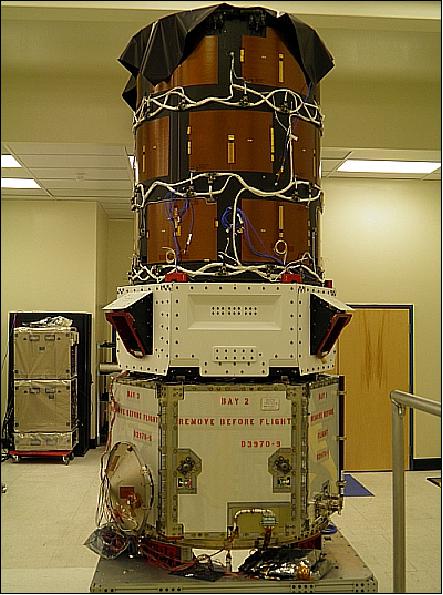
Launch
The ORS-1 spacecraft was launched from MARS (Mid-Atlantic Regional Spaceport) at NASA's Wallops Island Flight Facility aboard a Minotaur-I launch vehicle of OSC (Orbital Sciences Corporation) on June 29, 2011. 6) 7)
Orbit: Near circular orbit (LEO), altitude of ~ 425 km, inclination = 40º, period = 92.93 minutes.
Mission Status
• June 2016: ORS-1 is the first and only dedicated space intelligence capability for the USCENTCOM (U.S. Central Command), introducing Operationally Responsive Space and tactical ISR (Intelligence, Surveillance & Reconnaissance) from space as a new paradigm for the Department of Defense. As the first ORS operational satellite, the fielding of ORS-1 was tremendous accomplishment for our DoD (Department of Defense) and the ORS Office. ORS-1 has proven that significant military surveillance capability can be provided using a small satellite fielded in about two years for about $200 million, including space vehicle, launch, and all associated ground infrastructure and operations costs. The satellite, originally designed to operate for a year, reached orbit in June 2011 and continues to provide support. 8)
- ORS-1 provides USCENTCOM an assured ISR capability that cannot be preempted by support to other users. It is an enabler for sustaining operations and objectives in a highly volatile region and is laying the path for future rapid reaction space systems.
- Although originally dedicated to USCENTCOM support, ORS-1 capabilities have been extended beyond a single combatant commander. The vehicle was designed to support CENTCOM, but the ORS-1 team recognized it could do so much more. The program office sent word out to U.S. PACOM (Pacific and U.S Africa Commands), and reached out through the Joint Functional Component Command directly to combatant commander staffs to let them know we could support their tasking's too. As a result, ORS-1 now provides effects for PACOM on a regular basis and does so occasionally with AFRICOM and Special Forces commands. ORS-1 earned early combatant command acceptance in less than 90 days after liftoff and was named one of nation's top new technologies by the C4ISR magazine.
- ORS-1 added an integrated propulsion system to the ATK bus that has allowed ORS-1 to perform orbital decay maneuvers, contributing significantly to the overall operational lifetime of the spacecraft.
• The ORS-1 satellite and its payload are operating nominally in 2016. The US Strategic Command is considering a follow-on satellite as a replacement for the ORS-1 tactical surveillance satellite that is expected to reach the end of its operational life by 2017. ORS-1, launched on 29 June 2011, provides visible and infrared imagery to US forces operating in the Middle East and Southwest Asia. 9)
• The ORS-1 satellite and its payload are operating nominally; as of July 29, 2015 the ORS-1 mission completed its 4th year on orbit. The ORS-1 satellite is the first and only dedicated space-based ISR (Intelligence, Surveillance and Reconnaissance) capability for INTERCOM (U.S. Central Command); successfully demonstrating tactical IRS from space.
- "ORS-1 is two years beyond it's design life. It's the kind of system that ORS was set out to do: rapidly delivered, responsive capability, it is flexible to support a variety of different contingencies. We expect ORS-1 to continue for at least a couple more years" (Mike Gruss interview with Colonel John S. R. Anttonen, director of the U.S. Air Force's Operationally Responsive Space Office). 10)
- "One of the most important lessons of ORS-1 was the ground system. That was the first operational system flown on the Multi-Mission Space Operations Center. It's now one of five satellites that have flown on that system. As a matter of fact, the next system we're building, ORS-5, is going to fly on that system as well because we learned the lesson of open architecture and flexibility built in up front. That benefit has been huge across a lot of Space and Missile Systems Center programs and it's turning into a look at how we do ground systems across the board. "
• October 13, 2014: The U.S. Air Force has awarded UTC (United Technologies Corp.) Aerospace Systems of Danbury, Connecticut, a contract for continued support for a one-of-a-kind tactical surveillance satellite. Under the sole-source contract, which began Sept. 30 and could run through Dec. 31, 2016, if all options are exercised, United Technologies will continue to provide day-to-day operation, support and image processing for the satellite. The Air Force said it expects this to be the final sustainment contract for ORS-1 as the satellite is expected to reach its end of life in December 2016, the announcement said. 11)
• On June 29, 2013, the ORS-1 spacecraft completed its second year on orbit. 12)
• The ORS-1 spacecraft and its payload are operating nominally in 2013. ORS-1 is the first and only dedicated space intelligence capability for USCENTCOM (US Central Command), introducing Operationally Responsive Space as a new paradigm for DoD (Department of Defense). ORS-1 has met or exceeded its projected capabilities and additional capabilities and applications continue to unfold. 13)
• August 2012: ORS-1 has demonstrated that small satellites have the ability to provide affordable support in the responsive timescales associated with the operational military domain, with the result that U. S. military planners view space as the new military high ground. ORS-1 is an enabler for sustaining operations and objectives in a highly volatile region and is laying the path for future rapid reaction space systems. ORS-1 provides USCENTCOM (U.S. Central Command) an assured ISR (Intelligence, Surveillance, and Reconnaissance) capability that cannot be preempted by support to other users. 14)
• On July 9, 2012, Goodrich Corporation announced that the ORS-1 satellite marked its first anniversary in space. 15)
• On Jan. 3, 2012, Air Force Space Command Commander Gen. William Shelton declared the ORS-1 (Operationally Responsive Space-1) spacecraft had achieved initial/final operational capability. 16)
- What's most amazing about this milestone is that it represents a culmination of three interrelated systems — the ORS-1 satellite; the ground system architecture, known as the MMSOC (Multi-Mission Satellite Operations Center), and the mission planning system. 17)
• Early operations: ORS-1 provides intelligence, surveillance and reconnaissance support to troops in the USCENTCOM (U.S. Central Command) area of operations, including Afghanistan and Iraq. The 50th Space Wing took control of the satellite during September 2011 from the Space and Missile Systems Center, following 45 days of on-orbit checkout. 18)
• The ORS-1 spacecraft was declared fully operational on September 16, 2011 by the U.S. Air Force Space Command at Schriever Air Force Base, CO, following the successful on-orbit deployment and checkout of all systems. 19)
The team's intimate knowledge of ORS-1 and its capabilities directly led to the unhampered success of the 45-day on-orbit test with the transfer of SCA (Satellite Control Authority) to the 50th Space Wing in mid-September and early acceptance by USCENTCOM on September 23, 2012.
• The combined ORS-1 government/contractor team moved to Shriever AFB following the June 29th launch from NASA Wallops and quickly completed early orbit checkout involving initialization of the bus, GN&C system; checkout of safe mode, payload, and fault management, and propulsion systems; and GN&C characterization. A key event was the deployment of the aperture door and subsequent checkout of the SYERS-2 like payload. The team also provided procedural support as the 1/7 SOPS crews gained certification and proficiency from July through October 2011.
Sensor Complement
SYERS-2 (Senior Year Electro-Optical Reconnaissance System-2)
The ORS-1 sensor payload leverages the Goodrich SYERS-2 multispectral sensor, the primary imaging sensor on the U-2 reconnaissance plane. The flight heritage of the SYERS-2 sensor on airborne platforms, coupled with existing interoperable ground systems, enables the nearly seamless integration of the ORS-1 data products into the battlefield picture.
The SYERS-2 instrument is a pushbroom VIS/SWIR/MWIR high-resolution MSI (Multispectral Imager) developed at Goodrich, Danbury, CT. ATK's San Diego facility in California provided the ORS-1 payload's telescope structure under subcontract to Goodrich.
The MSI camera has an aperture of 40 cm and a FOV (Field of View) > 2º. The instrument is operating in 7 spectral bands (green, red, Pan, NIR, SWIR1, SWIR2, and MWIR). It uses TDI (Time Delay Integration) CCD detectors to compensate for ground motion, resulting in a resolution of 1 m in VIS and 4 m in SWIR. The system's observation capability in the SWIR and MWIR bands enables daytime and nighttime (24 hour) collection of imagery, penetrating haze and smoke. 20)
The system delivers GEOINT (GEO-spatial INTelligence) data to a distributed ground system. 21)

Ground Segment
Ground command and control activities use Air Force Space Command's MMSOC-GSA (Multi Mission Space Operations Center - Ground Support Architecture). The spacecraft team leveraged the MMSOC- GSA resulting in minimal development of unique software for the mission (Ref. 1).
The MMSOC ground system architecture was developed by the Space and Missile Systems Center (SMC) Space Development and Test Directorate to replace an aging ground system with a new, open system that could support unique technology demonstration flights and respond to space operational communities using limited personnel while lowering development and sustainment costs and reducing schedule without increasing technical risk. The MMSOC framework is flexible and compatible with both Research and Development, and Operations satellites, and uses a net-centric, service-oriented architecture.
The MMSOC ground system architecture provides telemetry, tracking, and control through the use of open-system and COTS components. It accommodates the integration of newly developed command and control systems through an incremental development process. The DOD experimental and demonstration satellites are typically one-of-a-kind missions designed to last about a year. The MMSOC ground system architecture supports every aspect of such missions, including planning, training, mission preparation, launch and early orbit operation, normal operation, data collection and dissemination, and vehicle health and safety monitoring. Some missions end the experimental phase with a residual operational capability.
The MMSOC ground system architecture has been designated as the primary satellite command and control capability for Air Force missions within the ORS Office. The Block I architecture was also used to support STPSat-2 in early 2010. MMSOC is a revolutionary approach to space operations - an operations center focused on forging a one-of-a-kind operations and acquisition team to demonstrate and field emerging space missions and satellite command and control technologies in a rapid, decisive manner. It is structured to operate a variety of satellite missions, including satellite initiatives without a program office, satellite missions of small scale (small constellations), new missions transitioning from concept toward full-scale operations and all research, development, test and evaluation satellites with operational utility remaining after test and evaluation are complete. The key to the ground system's effectiveness lies in its flexibility. The vision for MMSOC is to fly multiple missions, where an operator controlling ORS-1 with one computer while sitting next to someone who is controlling a completely different vehicle.
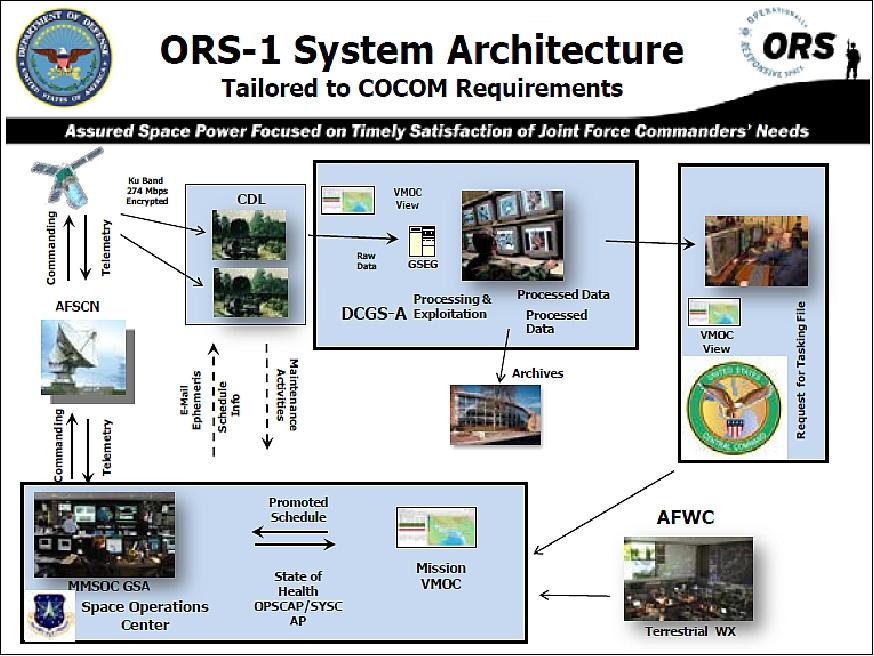
ORS-1 is operated 24/7 by the 1st and 7th Space Operations Squadron (1/7 SOPS) at the 50 Space Wing's Satellite Operations Center 11 (SOC-11) located on Schriever AFB, CO. The 1/7 SOPS plans, schedules, and operates ORS-1 using the Virtual Mission Operations Center (VMOC). 22)
VMOC (Virtual Mission Operations Center)
The VMOC, an automated tool for mission planning, tasking, and scheduling activities,developed by NRL (Naval Research Laboratory), was modified for the ORS-1 mission and existing tools were used for exploitation and dissemination. VMOC is a common planning, tasking, and scheduling interface that is integrated with tasking tools such as PRISM (Planning tool for Resource Integration Synchronization and Management) and with the MMSOC ground system architecture at Schriever Air Force Base. The automated interface between the tactical and mission components of the VMOC allows scalable mission planning with a "Fed-Ex" style capability that will allow users to track the status of their data requests. Using the tactical component of the VMOC as the tasking and sensor visualization tool in actual operations greatly assists in the refinement of organizational roles and responsibilities. It will provide insight into ORS availability and limitations, allowing operators to evaluate emerging requirements and apply the correct asset at the right time—without putting the platform at risk of being overtasked.
Both MMSOC and VMOC are trailblazing capabilities that will serve as the basis for streamlined support of multiple future space programs. The near-term focus for VMOC is on supporting the ORS-1 and TacSat-4 missions (launch Sept. 27, 2011).
VMOC's path to space operations has followed a multi-year process that began as a simple request to make space capabilities more accessible to users and evolved into proving a mechanism to collaboratively manage disparate space and ground systems consistent with increasingly dynamic and responsive operations. In support of the responsive space goals, the VMOC has served as a forcing function to bring intelligence, operational, and science agencies together to refine and implement operational relationships and roles that are required for rapid tasking processes.
With the successful launches of ORS-1 in June 2011 and TacSat-4 in September 2011, VMOC, now space-qualified, has fully demonstrated the power of web-based planning, as it continues to enable a new era of rapid planning and improved space responsiveness. It is now clear that the VMOC approach to worldwide tasking is not only feasible, but also practical.
ORS-1 is operated around the clock by the SOPS (Space Operations Squadron), located on Schriever AFB, CO. The ORS-1 program office worked closely with the Goodrich and its partners to ensure a viable space vehicle design derived from the proven TacSat-3 satellite along with reuse of 80% of its software. This enabled the launch vehicle interfaces and data analyses to also be preserved.
ORS-1 was able to fulfill massive intelligence requirements with the existing U-2 data processing system. This enabled the imagery to be instantly exploited by the existing CENTCOM intelligence infrastructure to Task/Process/Exploit/Disseminate. The technical team also effectively leveraged the Naval Research Lab's mission planning tool, VMOC.
In retrospect, it can be stated that ORS-1 proved its operational utility almost immediately, providing timely coverage and responsive fulfillment of theater taskings. The rapid acquisition avoided the burden of traditional top-down procurements and provides for future growth by leveraging upgrades in airborne/space assets achievable in the short term. The ORS-1 team devised an ingenious risk-based technical development and test program that tailored the approach to design decisions and performance verification (Ref. 1).
Between 2004 and 2008, the VMOC (Virtual Mission Operations Center) was developed through a series of operational demonstrations designed to support the standardization of spacecraft to ground interfaces needed to reduce costs, maximize space effects to the user, and allow the generation of new TTP (Tactics, Techniques and Procedures) needed to shape responsive space employment.
In 2008, VMOC development goals were refined to provide direct support to the TacSat-4 and ORS-1 missions. The launch of ORS-1 in June 2011 and TacSat-4 in September 2011 have now provided operations experience and lessons learned. These operations activities continue to serve as a forcing function for refining TTPs and concepts of operations.
The organizations that have been most involved in the VMOC development and testing include NASA, Air Force Battlelab, Army SMDC Battle Lab, ONR (Office of Naval Research), ORS (Operationally Responsive Space) Office, Blossom Point operations, MMSOC (Multi Mission Space Operations Center) operations, JSpOC (Joint Space Operations Center), and NRL (Naval Research Lab) as the program manager for VMOC.
Operational VMOC support to the ORS-1 imaging and TacSat-4 SATCOM missions has shown that it can reduce manpower and time requirements for scheduling satellite payloads during daily operations from hours to minutes. In the case of ORS-1, VMOC was designed and developed to support a single user though a single input interface.
References
1) Thomas M. Davis, James C. Barlow, "Operationally Responsive Space-1 (ORS-1)," Proceedings of the 4S (Small Satellites Systems and Services) Symposium, Portoroz, Slovenia, June 4-8, 2012, URL: http://digitalcommons.usu.edu/cgi/viewcontent.cgi?article=1089&context=smallsat
2) Operationally Responsive Space–1, Assured Space Power Focused on Timely Satisfaction of Joint Force Commanders' Needs," URL: http://ors.csd.disa.mil/media/ORS-1_Narrative_B002.pdf
3) Peter Wegner, "ORS Program Status," Reinventing Space Conference, El Segundo, CA, USA, May 7-10, 2012, presentation: RS2012-2012-A007, URL: https://web.archive.org/web/20150423114038/http://www.responsivespace.com/Papers/RS2012/SPECIAL%20SPEAKERS/Dr.%20Peter%20Wegner/Dr.%20Peter%20Wegner.pdf
4) "ORS-1 Reconnaissance Satellite, United States of America," URL: http://www.airforce-technology.com/projects/ors-1-reconnaissance-satellite/
5) http://isr.goodrich.com/documents/ORS-1%20for%20NSS-2012-Complete-1.pdf
6) Mark Pieczynski, "Orbital ‘s Role In Successful ORS-1 Launch," URL: http://www.ispcs.com/files/ww/files/presentations%202011/Mark%20Piecynski.pdf
7) Turner Brinton, "Pentagon's ORS-1 Imaging Satellite Carried to Orbit," Space News, June 30, 2011, p. 7, URL: http://www.spacenews.com/launch/110630-ors1-sat-orbit.html
8) Thomas M. Davis, Peter J. Thomas, Darrell B. Story, "Small satellites for operationally responsive space," Proceedings of the 4S (Small Satellites, System & Services) Symposium, Valletta, Malta, May 30-June 3, 2016, URL: http://congrexprojects.com/docs/default-source/16a02_docs/4s2016_final_proceedings.zip?sfvrsn=2
9) Jos Heyman, "TIROS Space Information News Bulletin," Vol. 41, No 10, July 2016, URL: https://3c.gmx.net/mail/client/attachment/download/tatt0_1---tmai145b8a6967e82e01
/;jsessionid=C7BE6F10DA11F3E00CFCCE7FE54B9E39-n1.bs74b
10) Mike Gruss, "ORS Director: "We're Not Here To Build Neat Toys", Space News, March 10, 2015, URL: http://spacenews.com/ors-director-were-not-here-to-build-neat-toys/
11) Mike Gruss, "UTC Wins Support Contract for ORS-1 as Satellite Nears End of Life," Space News, Oct. 13, 2014, URL: http://spacenews.com/42167utc-wins-support-contract-for-ors-1-as-satellite-nears-end-of-life/
12) "ORS-1 Satellite Completes Second Year in Space, PR Newswire, July 1, 2013, URL: http://ors.csd.disa.mil/media/2013%20July_ORS-1_2nd_Anniversary.pdf
13) Thomas M. Davis; Thomas Atwood, Valerie Skarupa, John Puffenbarger, "Operationally Responsive Space: Assured Space Power Focused On Timely Satisfaction of Joint Force Commander Needs," Proceedings of the 9th IAA Symposium on Small Satellites for Earth Observation, Berlin, Germany, April 8-12, 2013, paper: IAA-B9-1004
14) Thomas M. Davis, James C. Barlow, "Operationally Responsive Space-1 (ORS-1) Lessons Learned," Proceedings of the 26th Annual AIAA/USU Conference on Small Satellites, Logan, Utah, USA, August 13-16, 2012, paper: SSC12-XI-3
15) "Goodrich's ORS-1 Satellite Completes its First Year in Space," July 9, 2012, URL: http://isr.goodrich.com/press_ORS-1Birthday.html
16) Michael P. Kleiman, "Operationally Responsive Space-1 satellite declared mission ready," Jan. 30, 2012, URL: http://www.afmc.af.mil/news/story.asp?id=123287876
17) Scott Prater, "ORS-1, ground system gain final ops acceptance," Shriever Sentinel, Feb. 2, 2012, URL: http://www.schriever.af.mil/news/story.asp?id=123288487
18) Scott Prater, "ORS-1, ground system gain final ops acceptance," Feb. 3, 2012, URL: http://www.afspc.af.mil/news1/story_print.asp?id=123288487
19) "ATK Spacecraft Bus Contributes to Significant ORS-1 Milestone, ORS-1 Satellite Completes Successful On-Orbit Checkout, U.S. Air Force Declares Spacecraft Fully Operational" URL: http://www.prnewswire.com/news-releases
/atk-spacecraft-bus-contributes-to-significant-ors-1-milestone-130258638.html
20) Andy Choi, "Goodrich Supplies ORS-1 Satellite with SYERS-2 Multi-Spectral Sensor," April 30, 2011, URL: http://www.azosensors.com/News.aspx?newsID=2588
21) Stanley Kishner, David Flynn, Charles Cox, "E-O Reconnaissance Payloads for Responsive Space," AIAA 4th Responsive Space Conference , Los Angeles, CA, USA, April 24-27, 2006, paper: AIAA-RS4 2006-5003, URL: https://web.archive.org/web/20150607214737/http://www.responsivespace.com/Papers/RS4/Presentations/RS4_5003C_Kishner.pdf
22) Dominic N. Wong, Aaron P. Pinson, James M. Massey, "Operational Responsive Space: An Operational Squadron's Tactical Perspective," Reinventing Space Conference, March 2-5, 2011, Los Angeles, CA, USA, paper: AIAA-RS-2011-6004
23) Eric Miller, Joel Hicks, Mike Hurley, Matthew Anderson, James Barlow, Kim Holloman, Ed Quinonez, "VMOC and Responsive Space Ground System Operations," Reinventing Space Conference, May 7-10, 2012, Los Angeles, CA, USA, paper: AIAA-RS-2012-6002
The information compiled and edited in this article was provided by Herbert J. Kramer from his documentation of: "Observation of the Earth and Its Environment: Survey of Missions and Sensors" (Springer Verlag) as well as many other sources after the publication of the 4th edition in 2002. - Comments and corrections to this article are always welcome for further updates (eoportal@symbios.space).
Overview Spacecraft Launch Mission Status Sensor Complement Ground Segment References Back to top